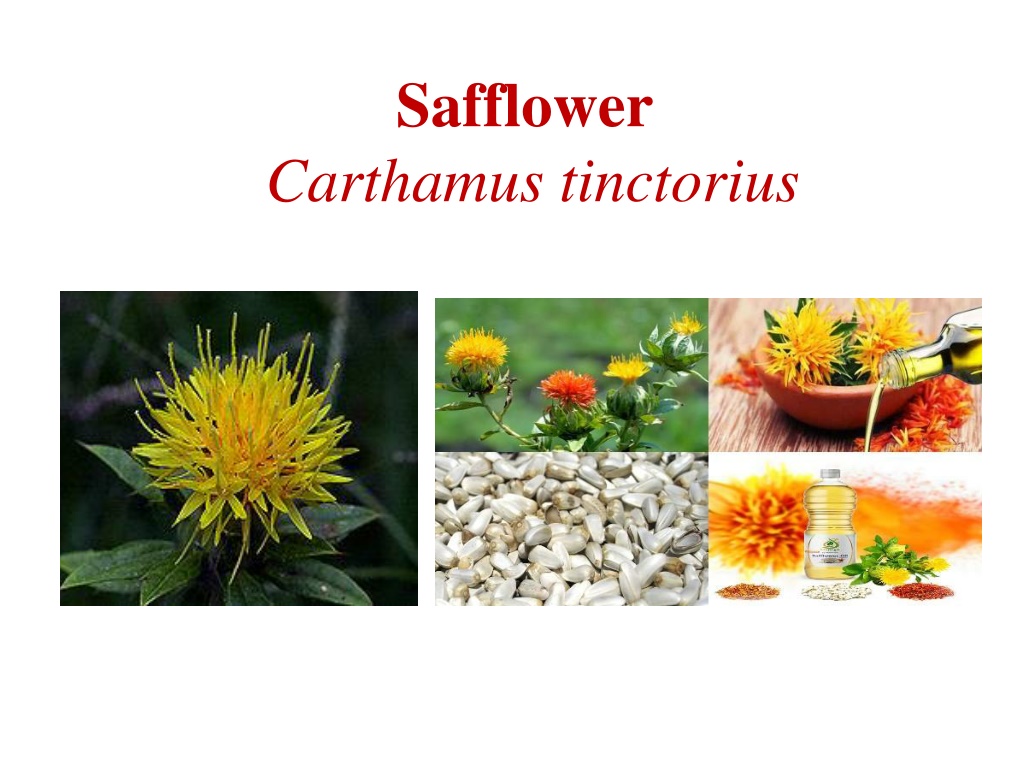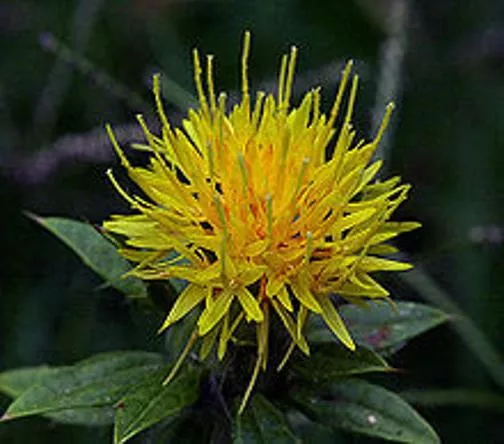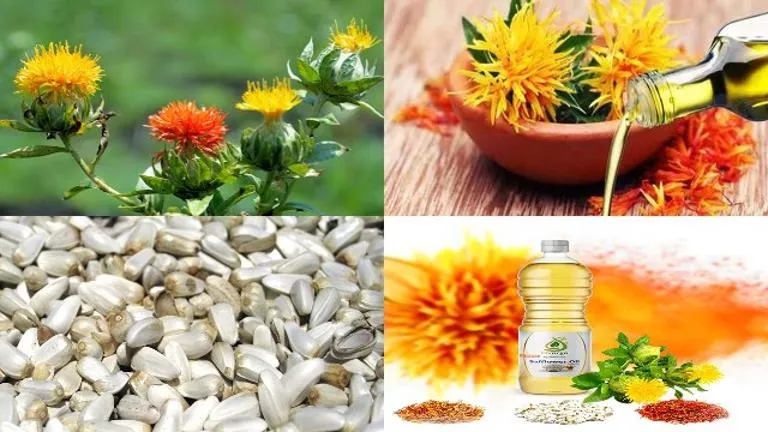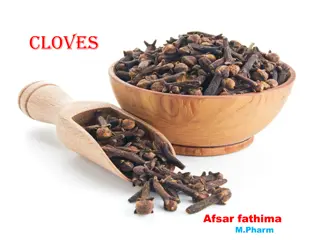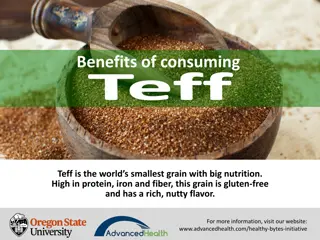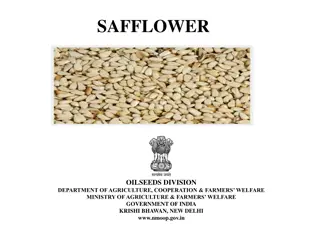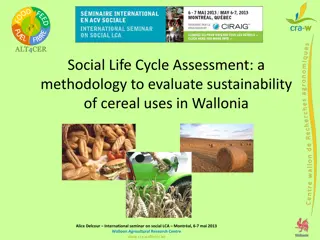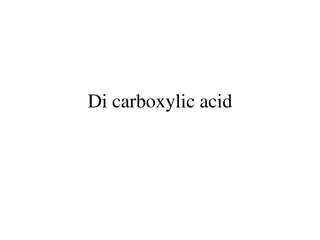The Versatile Safflower: History, Uses, and Benefits
Safflower, known as "Kusumbha" in Sanskrit literature, is a member of the Asteraceae/Compositae family. It is a minor oil seed crop rich in PUFA, benefiting blood cholesterol control and cooking. The plant has a long history, dating back thousands of years and is valued for its oil, flower extract, and medicinal properties. Despite challenges, safflower remains a valuable crop with diverse uses in food, medicine, and industry.
Download Presentation

Please find below an Image/Link to download the presentation.
The content on the website is provided AS IS for your information and personal use only. It may not be sold, licensed, or shared on other websites without obtaining consent from the author.If you encounter any issues during the download, it is possible that the publisher has removed the file from their server.
You are allowed to download the files provided on this website for personal or commercial use, subject to the condition that they are used lawfully. All files are the property of their respective owners.
The content on the website is provided AS IS for your information and personal use only. It may not be sold, licensed, or shared on other websites without obtaining consent from the author.
E N D
Presentation Transcript
Safflower Carthamus tinctorius
Its a member of asteraceae/compositae. It s a minor oil seed crop because of limited distribution and farmer s dont like to cultivate because of spiny nature. In India it is grown in century either for its orange, red carthamin extracted from brilliantly colored flower heads and or for much value oil. Synthetic dyes are come in to market. This has lead to almost disappearance of crop from its traditional areas of north and north east Asia. Now it is mainly confined to peninsular india.
Safflower is described as "Kusumbha" in sanscrit literature and most commonly "Kusum". Carthamus is latinised version of Arabic word "quartrum" or "qurtum" which also means color of dye obtained from flower heads.
Safflower produce oil rich in PUFA which is good for blood cholesterol control and it is also considered as good cooking oil used in preparation of salad and resins. Safflower oil is highly suitable frozen desserts as oil remain liquid even in frozen state. Oil is valued in technology of alkyd resins, used for manufacture of roghan, meant for preservation of leather, charred oil is used in healing of psoriasis and rheumatism. Safflower is used in liquid formulation and also effective as non allergic dispersant for injectable medicines. Dry red and orange flower has sold as substitute for saffron in middle east countries.
Flower is used in treating of circulatory system, inflammation muscular faligue. Safflower cake is used to feed ruminents and manogastric animals. Hulls can be used in preparation of cellulose insulation boards. Safflower leaves rich in carotein, riboflavin, young seedlings twigs are used as vegetable salads. Green safflower plant is used as fodder and also used after silage.
Origin and History: According to Vavilov (Expert taxonomist), Eastern type must have originated in India, or Ethiopia, while the western type must have originated from Fertile Crescent (Turkey, Syria and Lebanon) Plant is primitively identified as growing about 4000 years ago. Genus Carthamus has 25 species having different pairs of chromosomes 10, 11, 12, 22, 32. Only Carthamus tinctorius is cultivated and other species are wild in nature. Carthamus tinctorius is supposed to originate from C. lanatus, C. oxycantha, C. palestinus.
Area and distribution Safflower is grown in Africa, Latin America, North America, Australia and Africa besides Asian counties. Its major producers are India (2.32 lakh hectare), Kazakhstan (2.44 lakh hectare), Agrentina (1.61 lakh hectare) , Mexico (1.72 lakh hectare) as well as USA (0.65 lakh hectare) and China, Ethiopia, Tanzania and Turkey growing it on minor scale. Turkey and USA having a productivity of 1250 kg/ha, Mexico 1390 kg/ha, India 655 kg/ha. Global productivity is 845 kg/ha. In India, it is predominantly grown in the states of Maharashtra (1.64 lakh ha), Karnataka (53,000 ha) and Andra Pradesh.
Botanical description of plant Safflower is highly branched herba varying in height from 30-150 cm. Root: Plant has deep fleshy tap root system producing numerous thin laterals. Tap root penetrates to a depth of 1.5 3 metres. Stem: Stem is thick, cylindrical thick at base and become thinner as branching increases. Stem is smooth glabrous grey white in colour with longitudinal grooves on stem. Stem becomes brittle at the time of maturity. Central stem branches at an height of 15-20 cm. Pattern of branching is a varietal character. Leaves are deeply serrated at the base and ovate at the top. Inflorescence consists of numerous flowers collected closely together at circular and flattened receptacle.
Leaves are deeply serrated at the base and ovate at the top. Flowers: Inflorescence consists of numerous flowers collected closely together at circular and flattened receptacle. Fruits: The number of fruits varies with variety and varies from 80- 120. Fruit is called as achene, resembles small rectangular sunflower seeds and more thick and fibrous than sunflower. Test weight of seed is 2.5 to 8.08 g. Depending on cultivar safflower produces 20-100 developed seeds in each heads. Hull constitutes 30-64%.
Seeds after planting take six days to germinate and depend on soil temperature. First stage is rosette. It remains in that stage till temperature become favourable. It is a thermo sensitive crop. It forms rosette of basal leaves. During slow growing rosette stage, tap root develops and penetrates deep into soil. Subsequently central stem grow rapidly and branch extensively. Flowering normal begins at head region and proceeds centripetal and requires 3-5 days to complete. Since plant is multifloret, time to flowering extends to 5-8 days. Time of flowering has genetic control and is greatly influenced by environment. Seeds will be set at after 8 days after flowering. Safflower is basically self pollinated crop. But bees and other insects are necessary for optimum and maximum yield. Bees can increase yield for 5%.
Physiology: It is a C3 plant. It is not having as much productivity as that of sunflower. The duration of crop varies from 140-240 days because of multiflowers. Leaf area index of 4 to4.5 is observed at vegetative growth. Yield is highly correlated to 1000 seed weight that varies from 40-60 g. Plasticity of plant density is significant. Population varies from low to high with same yield levels. Yield levels are similar with 6-90 plants/m2. Important yield parameters are number of capsules/plant, diameter of capsule, number of grains/capitulum and test weight.
Climatic requirement Safflower is best grown in cool season of tropical and subtropical region and rarely in temperate region. It requires cool climate in the initial stage (15oC), but warm temperatures between 24-32oC and dry hot climates during maturity (30-35oC). Freezing temperatures at flowering may result into sterility. Continuous rains at flowering or even in the initial stages may damage the crop. It is drought tolerant crop and can extract subsoil moisture.
Climatic condition during crop growth affects soil moisture because of hot dry winds and adequate moisture of 300 mm of rainfall produces excellent yield if rainfall occurs prior to flowering. In India, area receiving rainfall of 600-1000 mm is being used for obtaining higher yield depending on soil types. Prolonged rainfall at flowering adversely affects pollination and fertilization causing discoloured seeds and small seed production. Crop cannot tolerate water logging at any stage of crop growth.
Soil requirement for safflower: Safflower can be grown in any well drained soil, but it is preferred to grow in clay rich soil with high water holding capacity. Safflower requires fertile deep and well drained soils because safflower can withstand drought but not waterlogging. Irrespective of fertility, shallow soils produce lower yields due to inadequate storage capacity of moisture. Water logging due to poor drainage as well as prolonged rainfall for shorter periods predisposes crop for damage of rootknot, wilt and decreases yield. Heavy soils with poor drainage should be avoided for safflower. Safflower is considered to be salt tolerant next to barley and cotton. It produces profitable yield even it is grown in saline soils. It is also having alkalinity tolerance similar to barley in rainfed condition.
Cropping system: It can fit, well in any cropping sequence and Inter cropping systems. Sequence cropping system: Karnataka- Moong bean-Safflower, Soybean- Safflower Ground nut- Safflower. In scanty rainfall areas of Karnataka, AP it is grown after sorghum/Moongbean/maize/Sorghum-Safflower. In assured rainfall areas Moong bean/Hybrid sorghum/Ground nut/Sesamum/Sunflower-Safflower. Drought prone areas of Maharashtra - Moong bean/ Urd bean/Soybean/Maize/Ground nut- Safflower.
Intercropping system: Maharastra Cowpea/Chickpea+ Safflower 3:1/2;1 Wheat+ Safflower, Linseed+ Safflower 4:1 Coriander+ Safflower 3:1 In Karnataka- Chickpea+ Safflower 3:1 Wheat+ Safflower 3:1 Coriander+ Safflower 2:1 In AP- Chick pea + Safflower 3:1 Wheat+ Safflower 3:1 Linseed+ Safflower 3:1.
Varieties: Large number of crop varieties have been hybrids are developed in this crop. AP- Hybrid- DSH-129, MKH-11, NARI-NH-1, NARI-6. Varieties- Manjira, Sagar muthyalu, Parbani kusum, Phuli kurum Karnataka- Varieties: S-144, A-1, A-300, A-2. Maharastra- Varieties: Bjhima, Sharada, Girnaur.
Land preparation Safflower requires clod free seed bed but does not require fine seed bed because fine seed bed forms crust immediately after rain and from subsoil is there should be enough moisture for germination and earlt establishment. In black soil of rabi areas, 3-4 harrowings during monsoon areas is as good as deep ploughing to keep fields weed free and also helps in conservation of moisture. To ensure greater weed control last harrowing should be done just prior to sowing because initial rosette stage is slow and smothering effect on weeds. If plots are infested with objectionable weeds, deep ploughing is necessary during summer.
Presoaking and seed treatment: Presoaking for 24-48 hours induces seed hardening in safflower induces drought tolerance. Soak seeds in water for 24-48 hours followed by shade drying for 4 hours and the treat with application of fungicides because many of diseases are seed borne in safflower. Therefore seed should treated with capton, Thyram/bavistin @ 3g/kg seeds.
Seed rate and spacing: Safflower has plasticity to seed rate because of its inherent branching potential. Optimum plant population in different conditions will never exceed 1,11,000 plants/ha. Seed rate depends on spacing, depth of sowing, previous crop grown, it varies from 7-20 kgs /ha. In peninsular India and northern India wide row spacing of 30-45 and 90 cm didn t cause any striking yield difference. Normally 45-60 cm row spacing is higher for safflower. AP- 7.5-10 kg/ha- 45x20 cm, Karnataka-7.5 kg/ha-45x20 cm Maharastra - Kharif fallows-10-12 kg/ha-45x20 cm When ever soil moisture is favourable excess seedling should be thinned with in 15-20 days.
Manures and Fertilizers Application of manure before final preparation of land @5-8 t/ha (heavy soils) or 12-15 t/ha (sandy and light soils) is necessary for the sole crop. For intercrop, no separate dose of manure is given, when the same is applied to the main crop. A dose of fertilizers @ 40:40:20 kg N, P2O5 and K2O per ha is necessary for the sole crop. For intercrop, one-fourth to one-third dose is necessary o be supplemented with the fertilizers given to the main crop.
Response to nutrienst N requirement: If preceeding crop is legume then 50% of N dose is reduced. In scanty rain fall areas, either top dressing of 20-25% is given. If soil moisture is favorable and post raining is expected/irrigated condition 50% basal and 50% top dress is better at 5 weeks later at time of 1st irrigation. P requirement: is moderate and minimum requirement has to be applied even when previous crop is applied with large quantity of P. Safflower responds very well to P in seedling stage. Safflower is deep rooted crop it draws more P from lower area. Therefore it is capable of drawing P from more volume of soil. K requirement: Application of K is usually unnecessary except in areas where deficiency is existing. In general, application of K to preceding crop is sufficient to safflower. It responds to 30 kg S and response to any fertilizer depends on method and time of application.
It is better to apply full quantity of fertilizer as basal in rainfed situation and placed 10 cm below surface. Under irrigated condition it is better to apply 50% N and full P and K as basal and 50% N top dress after 5 week after sowing. Beneficial effect of seed treatment with Azospirillum, Azatobacter, VAM and when applied in combination with FYM 6 t/ha + 20 kg N was found to increase yield by 42%. The biofertiliser also helps in increasing WUE thus alleviate harmful effects of drought and frost.
Water management As the crop roots are able to extract the soil moisture from deeper layers (even upto 1-1.5 m) in majority cases, it is grown as un irrigated crop. In case of sandy and lighter soils, it may be advantageous to irrigate once after 30-35 days. Its water requirement is 30-35 cm, and hence can be grown under limited soil moisture.
Weed control Critical period for competition by weeds extends up to 40 days, till stem elongation and branching do not happen. Control of the weeds till such time by hoeing after 20-40 days of sowing will ensure good control of the weeds,
Topping Topping is necessary to be done after 35-40 days to remove the apical shoot to promote more branching, which boost the flower production and result in higher yield.
Harvesting and yield The crop matures in 120-140 days, which is indicated by the yellow colour developed by the stem and leaves. Harvesting should always be done in the morning hours to avoid the trouble caused by the spines on the leaves (in mornings they are little softer). Entire plant is pulled and staked for 6-9 days and later threshed and winnowed. The yield from sole crop can be as high as 15-20 q/ha (Irrigated) or 10-12 q/ha (un irrigated), if the crop is well maintained. Intercrop yield varies from 4-8 q/ha.
